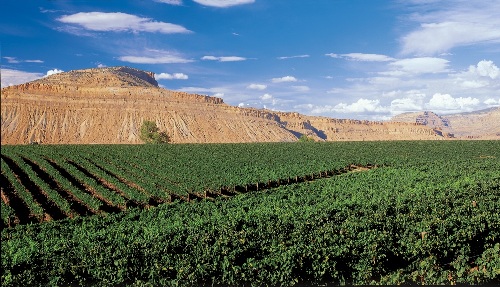May 12, 2011 —
What is Colorado wine?
On my Southwest Winery Tour, I was really interested in seeing what Colorado wine was all about. What I found is that the state has not defined what Colorado wine is actually (BTW, this is not unique to Colorado, and most states/regions are in the same boat). By that I mean, as a group of wineries in an area, how do you distinguish yourself from the rest? Example: Texas has the Hill Country, The High Plains, Gulf Coast, etc. and you know pretty well what you’re going to get within those regions. If it’s the Gulf Coast, you’ll find Black Spanish and Blanc du Bois among most wineries. If you’re in the High Plains, it will be Tempranillo and Viognier, and in the Hill Country, you’ll find more Italian style wines like Sangiovese.
Another challenge facing Colorado is that there are a lot of wineries for the volume of wine produced in the state. However, “winery” is a loose term in Colorado because there are many, many hobbyists who are permitted to be called wineries. You’re practically spammed by all these urban wineries (no vineyard, less than 500 cases per year) and it’s very difficult for the consumer to find the real wineries, like Avanti and Creekside Cellars, rather than someones “water2wine” or barrels in the garage. With an average of 1.9 winery stops by the typical destination winery tourist, the larger wineries are being caught up in the barrage of every “Tom, Dick and Harry” winery and the customer is giving up before getting to you. This digging through the muck is exactly what happened to me, so I know.
What Colorado needs are Wine Trails.
Through my research I did find Colorado wine trail maps, but they were really more or less a winery listing with a map created by the state Wine Industry Development Board. Many accomplished wineries were not listed, while others that don’t even have real store hours were. I’m suggesting the wineries create a wine trail: an organized, chartered group of wineries for a wine area. The charter will define what kind of winery can be admitted to the Wine Trail group. Standards and parameters are defined and have to be met for a winery to even apply.
Possible questions to ask in creating and standardizing the criteria to be a member of the Wine Trail:
1. Do you bottle at least #### cases per year?
2. What percent of Colorado fruit is used in crafting your wine blends?
3. Is your winery in the pre-defined area of the wine trail?
4. Are non-grape wineries allowed? Mead or fruit wines for example.
5. Is your Tasting Room and Winery open for set hours every week?
6. If you are in an area like The Four Corners, can you use fruit from neighboring states?
The Wine Trail organization must have a marketing and advertising budget. Every member pays dues into the budget. Period. It exists for marketing and advertising only – a true group marketing effort, and someone must be hired to do this. Through this you are calling the wineries to step up and create a true destination for people to visit. One winery does not a destination make. Reminder, on average a winery tourist visits 1.9 wineries in a day. If you have a wine trail that encourages them to go more than once (i.e. Wine Trail Passport or monthly events), they will visit other wineries on the trail. Whereas if they are on their own with no guidance, they may just keep going to the same couple of wineries they stumbled upon…and those may just be the closest…or simply not you.
Why is collaborating with your competitor a good thing?
Why do you want your neighboring winery to be better than he is now? Because you want to be proud to be associated with these wineries and you want visitors to say good things about Colorado wine. It is competitive, but by your neighbor making better wine, ALL of you do better. The industry grows, people start to talk about the great wines coming out of Colorado, overall sales increase and soon Colorado wine is making an impact. So, go ahead, meet with your neighbors, combine forces and build a meritable Wine Trail. Have events and festivals, create a “Wine Trail Passport” encouraging customers to visit ALL of the wineries on the Trail. This gives customers access to knowing more about you and understanding that these are accomplished, established wineries making quality wine….because there are real standards!
Let visitors know how great you are AND that you are a part of this association whose members have to meet certain qualifications. From there, customers will get that these are THE wineries to visit to find and enjoy the best local wine.
Salut!
Premier Wine Blends provides custom solutions for your winery.
Finely crafted wine blends, consulting and
local premium bulk wine sourcing (because you’re not a Napa winery!)

Brad Johnson
May 16, 2011
I’m a fan of Colorado wines and I agree, not only with Colorado, but with many new wine regions, that having a well-conceived, executed and organized association really makes a difference. I’d say look for excellent examples: Texas Hill Country and New York State (New York Wine & Grape Foundation).
Leadership makes a big difference!
I’ve visited the West Elks AVA (around Paonia) and had a great time and tasted some lovely wines.
Cheers!
Brad Johnson, editor at http://www.winedustry.com
Premier Wine Blends
July 9, 2012
A great example of small wineries working together to make each winery that much more successful.
http://www.news-leader.com/article/20120708/LIFE/307080038/Ozarks-wineries?odyssey=mod%7Cnewswell%7Ctext%7CFRONTPAGE%7Cs&nclick_check=1
blender
April 1, 2013
Great blog by The Academic Wino regarding Yang, McClusky & Brady’s white paper regarding the value of good neighbors and the benefits of them producing quality wine. http://bit.ly/ZwOjgm
Comments
Write a comment: